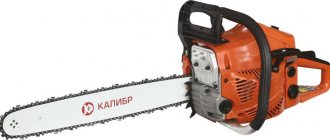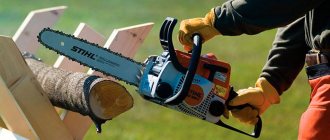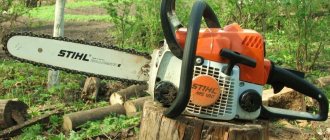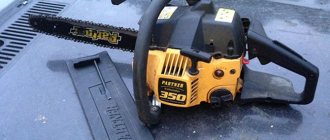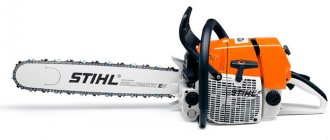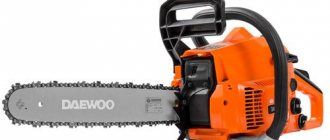The Champion 137 chainsaw is well suited for use in the garden and around the house. Among the many advantages of garden tools, the excellent quality of its components and factory assembly, a fairly long working life, and relatively low fuel consumption stand out. With proper and timely maintenance, the Champion 137 chainsaw shows high speed and good quality of cutting wood, leaving a smooth, neat cut line. This allows you to use the model not only for garden care, but also for construction work.
Purpose of Champion 137
The chainsaw is intended for household use only. It can be used in the country house, used for trimming branches or preparing firewood for the barbecue. The Champion 137 is suitable for outdoor enthusiasts as it is the lightest saw in the Champion line of household chainsaws.
The manufacturer's recommendations for the use of this chainsaw are rarely followed in our country, and therefore the Champion 137 can be found at sawmills where it is used to cut slabs. Private offices that collect and sell firewood to the public also often use this chainsaw.
The 137th model is popular because it has a low cost. Another advantage is the cost of repairs and a large number of spare parts. Specialized stores have a large selection of both original and made-to-measure handicraft spare parts.
Advantages
The tool is characterized by:
- affordable price for a wide range of owners of private and small farms;
- simple and time-consuming maintenance;
- compliance with the requirements for household chainsaw equipment in the small and medium power range;
- The advantages of this model are versatility, sufficient performance, economical maintenance and stable performance characteristics.
The product design uses modern design and technical solutions to ensure full production of the assigned resource.
Design Features
Champion 137 does not have any design features; everything is done as simply and cheaply as possible. The engine is ordinary - two-stroke, diaphragm carburetor, starter without additional springs, but this does not mean that the chainsaw is bad. It’s pleasant to hold in your hands and it starts up no worse than Husqvarna’s household model, for example, the 236th.
There are still minor improvements, such as an additional fuel pump, which is designed to make starting easier after a long period of inactivity, as well as a chain tension regulator mounted on the side cover, which is quite convenient.
In the latest versions of the Champion 137, the manufacturer added a hatch in the top cover, through which you can access the air filter and spark plug without the use of additional tools. Comfortable? Of course it’s convenient, because previously, every time you needed to check the cleanliness of the air filter, you had to unscrew the 4 screws securing the top cover and remove it completely.
The saw controls are made as simple as possible; there are no combination levers or anything else. A separate choke control lever, which is mounted on the body to the right of the rear handle. Reliable and inexpensive push-button ignition switch.
At first glance at the saw, it becomes clear that this is a budget option without any bells and whistles. Below you can watch a video test of the Champion 137 saw.
Engine Specifications
The tool's own weight of 4.5 kg is partially compensated by good balancing, comfortable grip and good placement of controls.
The Champion chainsaw model 137-16 is equipped with a high-speed carburetor internal combustion engine that uses gasoline and special motor oil in a ratio of 25:1 as fuel. The engine with a displacement of 37.2 cm3 at maximum speed develops a power of 2.1 hp.
The combustible mixture enters the carburetor from a 310 ml gas tank located in the body. To start the power unit, a manual starter is used; a quick start, regardless of external factors, is ensured by a primer pump, a correctly configured carburetor and an electronic ignition system.
| Model | Champion 137-16 |
| Manufacturer | Champion |
| Production (assembly) | China |
| Homeland of the brand | Russia |
| Saw class | Household |
| Power, hp (kW) | 2,1 (1,55) |
| Engine volume, cm3 | 37,2 |
| Chain pitch, inches | 3/8 |
| Chain thickness, mm | 1,3 |
| Number of links, pcs | 56 |
| Fuel tank volume, l | 0,31 |
| Oil tank volume, l | 0,21 |
| Tire length, cm (inches) | 40 (16) |
| Noise level, dB(A) | 106 |
| Warranty, years | 1 |
| Weight, kg | 4,5 |
| Instructions |
Equipment
The kit in which the chainsaw is delivered to store shelves is minimal and includes only a few things:
- user manual;
- warranty card;
- saw set (bar and chain);
- combination spark plug wrench;
- a screwdriver for adjusting the carburetor (not always);
- tire protective cover;
- canister for preparing the fuel mixture.
According to the manufacturer's information indicated on the official website, the configurations of Champion 137 that are available from sellers may differ from the official configuration.
Headset
The cutting unit of the saw consists of a steel 16-inch guide bar and a proprietary cutting chain with a standard pitch of 3/8 inches, which differs from similar models in its increased smoothness.
- Branded kits of identical or smaller sizes, corresponding to the specifics of the work ahead, can be used as replacement equipment.
- Automatic supply of lubricant to the working area prevents overheating of the chain and its forced wear. Special chain oil is supplied to the pump from a 210 ml oil tank located inside the saw body.
- The design of the tool provides convenient access to the chain tensioning mechanism.
Operator safety is ensured by the presence of an inertial emergency stop brake and a catcher to block a broken chain. The devices minimize the risk of injury to the operator when the tool is thrown, the chain comes off the bar, or other unfavorable situation.
DIY repair
You can repair the Champion 137 either at a service center or yourself. Typical malfunctions of this model are as follows:
- lack of spark;
- stopping the fuel supply;
- carburetor malfunctions (clogs, defects in the injector valve, defects in the main chamber membranes and fuel pump);
- air leakage into the crankcase through the gasket or seals;
- carburetor depressurization.
If you have some experience, you can diagnose and fix faults yourself.
If for some reason the chainsaw does not hold or picks up speed at idle, this is the first sign of air leaking into the crankcase or carburetor. It is impossible to operate a saw with such a malfunction, since overheating and jamming of the engine will follow.
How to disassemble champion 137
In order to disassemble Champion 137 yourself you need to know only two basic rules:
- The flywheel and clutch are unscrewed as the chainsaw moves.
- In order to block the crankshaft from turning, you need to use a special corkscrew or cord with knots tied to it, which is installed through the spark plug hole and blocks the piston stroke.
The chainsaw parts are removed in the following order;
- top cover;
- starter and chain brake cover;
- flywheel and clutch;
- carburetor and muffler;
- engine.
When assembling, the reverse sequence must be observed.
The Champion 137 chainsaw housing must be installed with red sealant; the sealant cannot be used anywhere else.
If, when disassembling the Champion 137 chainsaw, the carburetor gaskets and spacers were damaged, then they must be replaced during reassembly, otherwise the saw will suck in air and all repairs will be in vain.
In order to check the crankshaft seals for air leaks in the absence of a special tool, you can use the following method.
Remove the flywheel, clutch and carburetor from the chainsaw, then use a syringe to pour kerosene into the engine crankcase (if there is no kerosene, then you can use the fuel mixture), while visually checking the seals for leaks. If there are leaks, then the seals are defective and need to be replaced.
Analogs
Many leading manufacturers specialize in the production of small and medium-sized household chainsaws. Popular models on the domestic market include Hyundai X 360, Partner P340S-14, CubCadet CC 1936, AL-KO BKS 4040 and a number of other budget-class developments.
Adjusting the carburetor of the Champion 137 chainsaw
Adjustment can correct the situation only when there is no air leak in the saw and the fuel system is clogged, and the chainsaw continues to gain speed at idle or does not develop speed and full power.
The Champion 137 carburetor is a diaphragm carburetor and has three standard adjustment screws (H), (T) and (L). Correct setup is carried out according to the following algorithm:
- with the engine turned off, all screws except (T) are set to a position of 1.5-2 turns from the fully tightened state;
- start the saw and let it warm up for several minutes;
- by tightening the screw (L), find the maximum number of revolutions at idle, then loosen the screw by ¼ turn;
- screw (T) is used to adjust the idle speed to 3000; if the adjustment is made without a tachometer, then the screw (T) is unscrewed until the chain on the saw stops spinning;
- by tightening the screw (H), set 12,500 rpm; if there is no tachometer, then by ear the maximum rpm is found with the throttle fully open, after which the screw is unscrewed by one quarter of a turn.
A properly adjusted carburetor ensures stable engine idling and makes it responsive.
How a chainsaw carburetor works and works
The main purpose of the carburetor is to mix fuel with air in certain proportions. If the proportions are not respected, this will lead to disruption of the motor and will also speed up the time of failure of the chainsaw. If there is a lot of air in the supplied fuel, then such a mixture is considered lean, and if, on the contrary, there is little air, then supersaturation (enrichment) occurs.
It is important to know! The fuel mixture in the required proportions of air and fuel must enter the cylinder, for which the carburetor is responsible.
The main structural elements of the unit in question are:
- Base. It is a tube through which air is supplied. In the middle of the tube there is a valve, the position of which can be changed.
- Diffuser. It is the narrowed part of the tube. By means of a diffuser, the air supply speed increases at the point of fuel entry.
- Fuel channels. Through the channels, fuel is supplied to the atomizer.
- Float chamber. The chamber contains a fuel mixture that enters the nozzle. It is a container in which a constant fuel level is maintained.
The chainsaw carburetor diagram is a simplified model of devices used on cars. The operating principle of the unit in question is to supply air to a special zone or diffuser. In this case, the air must be filtered, for which all chainsaws are equipped with filters. The air flow is regulated thanks to the damper. Fuel is supplied from the fuel supply pipe by creating a vacuum. The fuel supply is regulated thanks to the presence of a fuel needle or nozzle connected to the float chamber. A simplified diagram of a chainsaw carburetor is presented below.
Owner reviews
Alexander. 45 years. Beloyarsk.
For more than a year and a half I have been the owner of a Champion 137. I really like the saw, although I rarely use it, only when I need to prepare firewood for the barbecue and bathhouse. In all the time that I have owned this saw, it has failed only once. As it turned out later, I myself violated the launch algorithm and filled the candle. After reading the instructions, I found out how to ventilate the engine after an unsuccessful start-up attempt and started the saw myself, although it smoked heavily for some time, but then the exhaust returned to normal. I'm happy with the saw and recommend it.
Ivan. 56 years old. Kursk
I bought a Champion 137 after my Shtil 180 broke down, and the cost of repairs turned out to be equivalent to buying a Champion 137. Now I regret it a little. As soon as you take the Champion in your hands, you immediately feel the difference with the Calm. The saw starts worse when hot and cuts worse, but I reassure myself that I paid for it almost half as much as the new Shtil 180 costs. Most likely, this saw will suit those who have not previously dealt with chainsaws.
Let's look at several situations
Knowing which part may fail is not enough. Outwardly, many breakdowns look the same: the chainsaw does not start or stalls immediately, does not gain power or cannot withstand the load.
Let's look at several situations when the chainsaw does not pick up speed and stalls:
- The most common problem is that the chainsaw stalls when you press the gas. You will need to check the fuel filter and fuel hoses, muffler, and seals on the crankshaft.
- The tool stalls immediately after starting. Most likely there is too much oil in the fuel mixture. Because of this, the saw only works on suction.
- If the saw operates only on “suction”, it is worth checking the fuel pump - perhaps gasoline is leaking. You will have to replace the gasket or the entire pump.
- The chainsaw starts poorly and stalls almost immediately. The problem is with the spark plug: it is filled with oil or covered with carbon deposits. It is necessary to carefully pull it out and clean it without damaging the contacts.
- Stops working when the tool is tilted. There is too little fuel left in the tank.
- The saw stalls as soon as it starts working or if you release the gas. Perhaps the carburetor settings are wrong or there is an air leak.
- Stops working at the slightest load. The problem may be a clogged air or fuel filter. It is also worth checking the flanges and gaskets, clutch operation, and adjusting the carburetor.
- If the chainsaw stalls at idle, the reason may be a clogged muffler or an increase in the gap between the wire and the spark plug. In the first case, you will need to clean the muffler, in the second, you will need to adjust the gap.
- If the saw stalls at maximum speed, the problem is a clogged fuel filter (it will have to be replaced) or a breather (it should be cleaned).
- The chainsaw stalls after heating and does not start until it cools down. It is worth checking the tightness of gaskets, seals and hoses (for “leakage”), checking carbon deposits on the muffler, carburetor settings and ignition coil. If everything is in order, then the cause may be a faulty CPG.
- If the tool is spewing fuel into the air filter, it is worth checking the carburetor. It needs repair or replacement.


